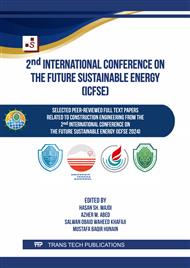[1]
Yeh, S.-C. (2019). High Performance Natural Lighting System combined with SPSC. Renewable Energy, 143, 226–232
DOI: 10.1016/j.renene.2019.05.002
Google Scholar
[2]
Najjar, G.A., Akkad, K. and Almahdaly, A.H. (2023). Classification of Lighting Design Aspects in Relation to Employees' Productivity in Saudi Arabia. Sustainability, 15(4), p.3614.
DOI: 10.3390/su15043614
Google Scholar
[3]
Kazem, H.A., Yousif, J., Chaichan, M.T. and Al‐Waeli, A.H. (2019). Experimental and deep learning artificial neural network approach for evaluating grid‐connected photovoltaic systems. International Journal of Energy Research, 43(14), pp.8572-8591.
DOI: 10.1002/er.4855
Google Scholar
[4]
Voordt, T.V.D. and Jensen, P.A. (2023). The impact of healthy workplaces on employee satisfaction, productivity and costs. Journal of Corporate Real Estate, 25(1), pp.29-49.
DOI: 10.1108/jcre-03-2021-0012
Google Scholar
[5]
Al-Waeli, A.H., Kazem, H.A., Chaichan, M.T. and Sopian, K. (2019). Photovoltaic/thermal (PV/T) systems: principles, design, and applications. Springer Nature.
DOI: 10.1007/978-3-030-27824-3
Google Scholar
[6]
Hu, X. (2021). Application method of natural light in architectural design. IOP Conference Series: Earth and Environmental Science, 621(1), 012037
DOI: 10.1088/1755-1315/621/1/012037
Google Scholar
[7]
Chen, H.-Y., Whang, A. J.-W., Chen, Y.-Y., & Chou, C.-H. (2020). The hybrid lighting system with natural light and led for tunnel lighting. Optic, 203, 163958. https://doi.org/
DOI: 10.1016/j.ijleo.2019.163958
Google Scholar
[8]
Lee, K. (2022). 2022 solid-state lighting Ramped opportunities. https://doi.org/10.2172/ 1862626
Google Scholar
[9]
Lim, G.-H., Keumala, N., & Ghafar, N. A. (2017). Energy saving potential and visual comfort of task light usage for offices in Malaysia. Energy and Buildings, 147, 166–175
DOI: 10.1016/j.enbuild.2017.05.004
Google Scholar
[10]
Turan, I., Chegut, A., Fink, D., & Reinhart, C. (2020). The value of daylight in office spaces. Building and Environment, 168, 106503. https://doi.org/10.1016/j.buildenv. 2019.106503
DOI: 10.1016/j.buildenv.2019.106503
Google Scholar
[11]
Abdelaziz Mahmoud, N. S., El Samanoudy, G., & Jung, C. (2023). Simulating the natural lighting for a physical and mental well-being in residential building in Dubai, UAE. Ain Shams Engineering Journal, 14(1), 101810
DOI: 10.1016/j.asej.2022.101810
Google Scholar
[12]
Pilechiha, P., Mahdavinejad, M., Rahimian, F.P., Carnemolla, P. and Seyedzadeh, S. (2020). Multi-objective optimisation framework for designing office windows: quality of view, daylight and energy efficiency. Applied Energy, 261, p.114356.
DOI: 10.1016/j.apenergy.2019.114356
Google Scholar
[13]
Al‐Waeli, A.H., Kazem, H.A., Yousif, J.H., Chaichan, M.T. and Sopian, K. (2019). Mathematical and neural network models for predicting the electrical performance of a PV/T system. International Journal of Energy Research, 43(14), pp.8100-8117.
DOI: 10.1002/er.4807
Google Scholar
[14]
Liu, R., Fan, X., Zhu, M., Hou, M. and Luo, Z. (2020). Real-world underwater enhancement: Challenges, benchmarks, and solutions under natural light. IEEE transactions on circuits and systems for video technology, 30(12), pp.4861-4875.
DOI: 10.1109/tcsvt.2019.2963772
Google Scholar
[15]
Kazem, H.A., Al-Waeli, A.H., Chaichan, M.T., Al-Mamari, A.S. and Al-Kabi, A.H. (2017). Design, measurement and evaluation of photovoltaic pumping system for rural areas in Oman. Environment, Development and Sustainability, 19, pp.1041-1053.
DOI: 10.1007/s10668-016-9773-z
Google Scholar
[16]
Xiong, J., Hsiang, E.L., He, Z., Zhan, T. and Wu, S.T. (2021). Augmented reality and virtual reality displays: emerging technologies and future perspectives. Light: Science & Applications, 10(1), p.216.
DOI: 10.1038/s41377-021-00658-8
Google Scholar
[17]
Vasquez, N. G., Rupp, R. F., Andersen, R. K., & Toftum, J. (2022). Occupants' responses to window views, daylighting, and lighting in buildings: A critical review. Buildingand Environment, 219, 109172
DOI: 10.1016/j.buildenv.2022.109172
Google Scholar
[18]
Kwong, Q. J. (2020). Light level, visual comfort, and lighting energy savings potential in a green-certified high-rise building. Journal of Building Engineering, 29, 101198. https://doi.org/
DOI: 10.1016/j.jobe.2020.101198
Google Scholar
[19]
Azis, S. S. (2021). Improving present-day energy savings among green building sector in Malaysia using benefit transfer approach: Cooling and lighting loads. Renewable and Sustainable Energy Reviews, 137, 110570
DOI: 10.1016/j.rser.2020.110570
Google Scholar
[20]
Udi, U.J., Yussof, M.M., Ayagi, K.M., Bedon, C. and Kamarudin, M.K. (2023). Environmental degradation of structural glass systems: A review of experimental research and main influencing parameters. Ain Shams Engineering Journal, 14(5), p.101970.
DOI: 10.1016/j.asej.2022.101970
Google Scholar
[21]
Habib, N.A., Ali, A.J., Chaichan, M.T. and Kareem, M. (2021). Carbon nanotubes/paraffin wax nanocomposite for improving the performance of a solar air heating system. Thermal Science and Engineering Progress, 23, p.100877.
DOI: 10.1016/j.tsep.2021.100877
Google Scholar



